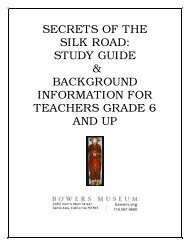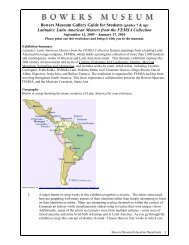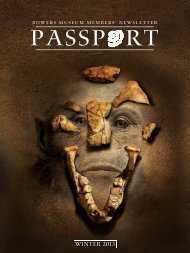A Resource Guide for Students and Teachers - Bowers Museum
A Resource Guide for Students and Teachers - Bowers Museum
A Resource Guide for Students and Teachers - Bowers Museum
You also want an ePaper? Increase the reach of your titles
YUMPU automatically turns print PDFs into web optimized ePapers that Google loves.
Chinese Culture <strong>and</strong><br />
the Cali<strong>for</strong>nia Curriculum<br />
Cali<strong>for</strong>nia Academic Content<br />
St<strong>and</strong>ards <strong>for</strong> Grade 6<br />
Visual Arts, History/Social Science,<br />
English/Language Arts, Science<br />
This guide supports the attainment of<br />
the following st<strong>and</strong>ards <strong>for</strong> Cali<strong>for</strong>nia<br />
Public Schools. Only the specific<br />
st<strong>and</strong>ards highlighted in the lessons<br />
in this guide are listed. Not all the<br />
st<strong>and</strong>ards are covered.<br />
Reading<br />
Word Recognition<br />
1.1 Read aloud narrative <strong>and</strong><br />
expository text fluently <strong>and</strong><br />
accurately <strong>and</strong> with appropriate<br />
pacing, intonation <strong>and</strong><br />
expression.<br />
Comprehension <strong>and</strong> Analysis of<br />
Grade-Level-Appropriate Text<br />
2.3 Connect <strong>and</strong> clarify main ideas by<br />
identifying their relationships to<br />
other sources <strong>and</strong> related topics.<br />
2.4 Clarify an underst<strong>and</strong>ing of texts<br />
by creating outlines, logical notes,<br />
summaries, or reports.<br />
3.0 Literary Response <strong>and</strong> Analysis<br />
Structural Forms of Literature<br />
3.2 Analyze the effect of the qualities<br />
of the character (e.g., courage or<br />
cowardice, ambition or laziness)<br />
on the resolution of the conflict.<br />
3.5 Recognize the speaker <strong>and</strong><br />
recognize the difference between<br />
first- <strong>and</strong> third-person narration<br />
(e.g., autobiography compared<br />
with biography).<br />
Literary Criticism<br />
3.8 Critique the credibility of<br />
characterization <strong>and</strong> the degree<br />
to which a plot is contrived or<br />
realistic.<br />
Writing<br />
1.0 Writing Strategies<br />
<strong>Students</strong> write clear, coherent,<br />
<strong>and</strong> focused essays. The writing<br />
exhibits students’ awareness of<br />
the audience <strong>and</strong> purpose. Essays<br />
contain <strong>for</strong>mal introductions,<br />
supporting evidence, <strong>and</strong><br />
conclusions. <strong>Students</strong> progress<br />
through the stages of the writing<br />
process as needed.<br />
Organization <strong>and</strong> Focus<br />
1.2 Create multiple-paragraph<br />
expository compositions:<br />
a. Engage the interest of the<br />
reader <strong>and</strong> state a clear<br />
purpose.<br />
b. Develop the topic with<br />
supporting details <strong>and</strong><br />
precise verbs, nouns, <strong>and</strong><br />
adjectives to paint a visual<br />
image in the mind of the<br />
reader.<br />
c. Conclude with a detailed<br />
summary linked to the<br />
purpose of the composition.<br />
1.3 Use a variety of effective <strong>and</strong><br />
coherent organizational<br />
patterns, including comparison<br />
<strong>and</strong> contrast; organization by<br />
categories; <strong>and</strong> arrangements by<br />
spatial order, order of importance,<br />
or climactic order.<br />
Curriculum Connections<br />
Listening <strong>and</strong> Speaking<br />
1.0 Listening <strong>and</strong> Speaking Strategies<br />
<strong>Students</strong> deliver focused, coherent<br />
presentations that convey<br />
ideas clearly <strong>and</strong> relate to the<br />
background <strong>and</strong> interests of<br />
the audience. They evaluate the<br />
content of oral communication.<br />
Comprehension<br />
1.3 Identify the tone, mood, <strong>and</strong><br />
emotion conveyed in the oral<br />
communication.<br />
2.3 Write research reports:<br />
b. Support the main idea or<br />
ideas with facts, details,<br />
examples, <strong>and</strong> explanations<br />
from multiple authoritative<br />
sources (e.g., speakers,<br />
periodicals, online<br />
in<strong>for</strong>mation searches).<br />
World History <strong>and</strong> Geography:<br />
Ancient Civilizations<br />
<strong>Students</strong> in grade six exp<strong>and</strong> their<br />
underst<strong>and</strong>ing of history by studying<br />
the people <strong>and</strong> events that ushered in<br />
the dawn of the major Western <strong>and</strong><br />
non-Western ancient civilizations.<br />
Geography is of special significance<br />
in the development of the human<br />
story. Continued emphasis is placed<br />
on the everyday lives, problems, <strong>and</strong><br />
accomplishments of people, their<br />
role in developing social, economic,<br />
<strong>and</strong> political structures, as well<br />
as in establishing <strong>and</strong> spreading<br />
ideas that helped trans<strong>for</strong>m the<br />
world <strong>for</strong>ever. <strong>Students</strong> develop<br />
higher levels of critical thinking<br />
by considering why civilizations<br />
developed where <strong>and</strong> when they did,<br />
why they became dominant, <strong>and</strong><br />
why they declined. <strong>Students</strong> analyze<br />
the interactions among the various<br />
cultures, emphasizing their enduring<br />
contributions <strong>and</strong> the link, despite<br />
time, between the contemporary <strong>and</strong><br />
ancient worlds.<br />
6.6 <strong>Students</strong> analyze the geographic,<br />
political, economic, religious,<br />
<strong>and</strong> social structures of the early<br />
civilizations of China.<br />
2. Explain the geographic<br />
features of China that made<br />
governance <strong>and</strong> the spread<br />
of ideas <strong>and</strong> goods difficult<br />
<strong>and</strong> served to isolate the<br />
country from the rest of the<br />
world.<br />
3. Know about the life of<br />
Confucius <strong>and</strong> the<br />
fundamental teachings of<br />
Confucianism <strong>and</strong> Taoism.<br />
4. Identify the political <strong>and</strong><br />
cultural problems prevalent<br />
in the time of Confucius <strong>and</strong><br />
how he sought to solve them.<br />
5. List the policies <strong>and</strong><br />
achievements of the emperor<br />
Shihuangdi in unifying<br />
northern China under the<br />
Qin dynasty.<br />
Visual Arts<br />
1.0 Artistic Perception<br />
Processing, Analyzing, <strong>and</strong><br />
Responding to Sensory<br />
In<strong>for</strong>mation Through the<br />
Language <strong>and</strong> Skills Unique to<br />
the Visual Arts<br />
<strong>Students</strong> perceive <strong>and</strong> respond to<br />
works of art, objects in nature,<br />
events, <strong>and</strong> the environment.<br />
They also use the vocabulary of<br />
the visual arts to express their<br />
observations.<br />
Develop Visual Arts Knowledge<br />
<strong>and</strong> Vocabulary<br />
1.1 Identify <strong>and</strong> describe all the<br />
elements of art found in selected<br />
works of art (color, shape/<strong>for</strong>m,<br />
line, texture, space, <strong>and</strong> value).<br />
Analyze Art Elements <strong>and</strong><br />
Principles of Design<br />
1.4 Describe how balance is effectively<br />
used in a work of art (e.g.,<br />
symmetrical, asymmetrical, <strong>and</strong><br />
radical).<br />
2.0 Historical <strong>and</strong> Cultural Context<br />
Underst<strong>and</strong>ing the Historical<br />
Contributions <strong>and</strong> Cultural<br />
Dimensions of the Visual Arts<br />
<strong>Students</strong> analyze the role <strong>and</strong><br />
development of the visual arts<br />
in past <strong>and</strong> present cultures<br />
throughout the world, noting<br />
human diversity as it relates to the<br />
visual arts <strong>and</strong> artists.<br />
3.2 View selected works of art from<br />
a culture <strong>and</strong> describe how they<br />
have changed or not changed in<br />
theme <strong>and</strong> content over a period<br />
of time.<br />
v





